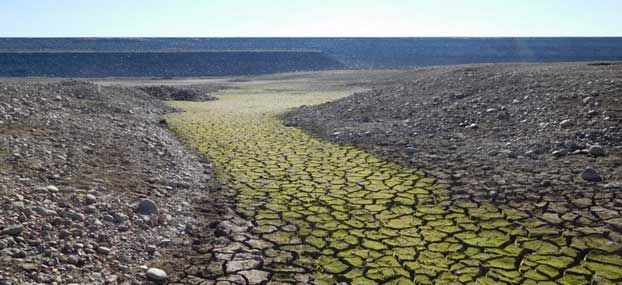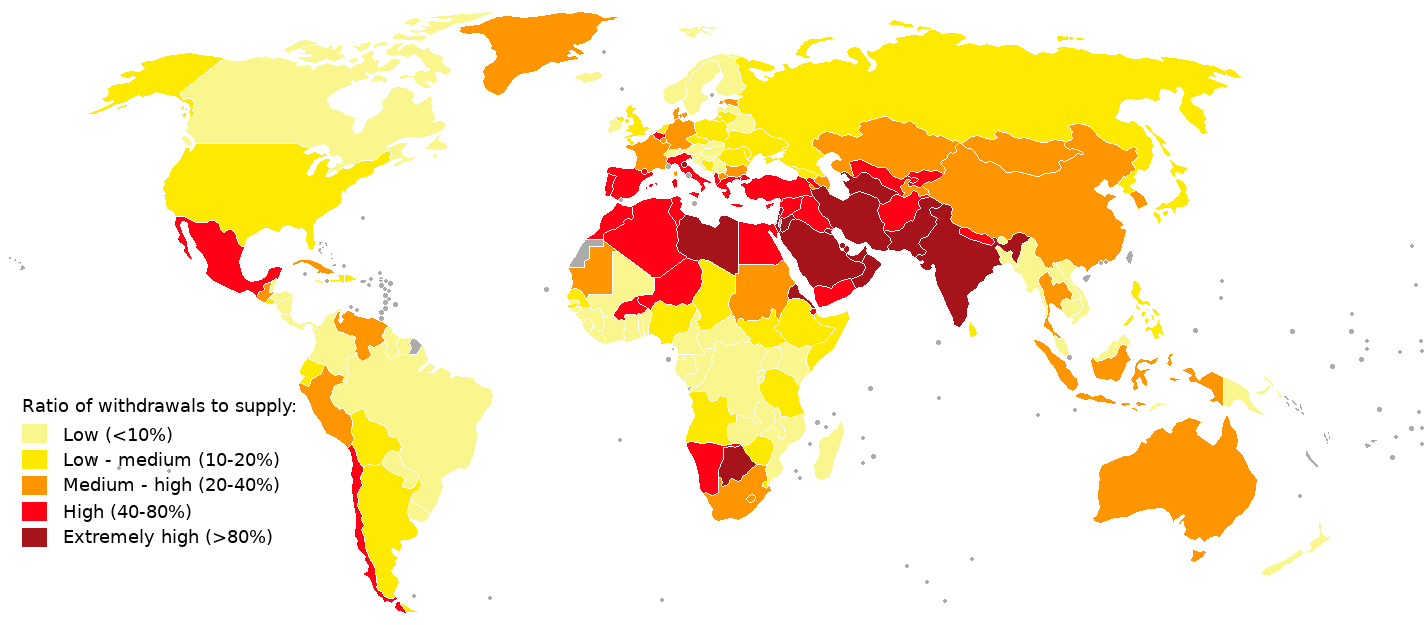What Is Water Stress
Less than 1 percent of global water is available for human use; the rest is either ocean saltwater, water frozen in glaciers, or water that is too polluted or inaccessible. Water infrastructure ensures that water is available when needed for drinking, irrigation, recreation, or ecological purposes. Sometimes these processes break down due to economic, political or climate events. When this happens, water stress can cause significant disruption to the health and safety of many communities. Access to drinking water is a fundamental human right. Yet, around 700 million people worldwide suffer from water scarcity, a number that is predicted to rapidly increase in coming decades.

Climate change and a growing rise in the use of freshwater have caused water stress to have a massive impact throughout the world. Notable cities across the globe such as Rome, Lima, and Cape Town have had to ration water. The Middle East and North Africa is the most water stressed location on earth, but its effects have been felt in a wide variety of countries and climates. Observed effects of this stress include:
- Dehydration and Hunger: The lack of water is itself a significant issue for human health, but water shortages often lead to failed crops and livestock death as well.
- Economic Stress: A lack of water impacts the whole economy. Without it, trade is interrupted and people prioritize water over other basic needs like education and employment. Within the U.S., drought conditions have caused severe disruption to needed housing development in drought-prone areas.
- Sanitation Issues and Disease: Water stress often causes people to be forced to rely on water that is contaminated and unsafe. Lack of water and sanitation can also expose people to preventable health risks such as: cholera, diarrhea, dysentery, typhus, and hepatitis A.
- Conflict: The global and human rights issue created by large-scale water stress has already become a source of international tension due to climate migration. Water sources often cross regional and international boundaries, which can cause tension over extraction rights.
- Wildlife and Biodiversity Loss: When lakes, rivers, and freshwater resources are excessively drained, it disrupts the ecosystem and threatens native species. Low water levels can lead to higher salinity, pollution, and dry floodplain and wetland habitats.
What Does Water Stress Mean?
Water is an integral part of our climate and weather systems. When something goes wrong within the water cycle or water processing infrastructure that causes a disruption to water services, it can be hard to define exactly where the problem originates. Here are a few definitions to know about water-related vulnerabilities:
- Water Scarcity: The quantitative lack or abundance of water supply. This is typically measured by the ratio of human water consumption to the amount of available water supply within a particular area.
- Water scarcity can be either physical or economic. With physical scarcity, the population exceeds the available water supply. Economic scarcity describes when the amount of available water should be adequate but lack of water infrastructure makes it difficult for that water to reach the population.
- Water Stress: The ability of water supplies to meet human and ecological needs for water. When the demand for water exceeds the available amount during a certain period of time or while the quality of the water limits its use. This metric includes environmental factors that could impact access to and the usability of water.
- Water Risk: Drought and flooding can cause massive damage to humans infrastructure and environmental systems, especially with the impact of climate change. Water risk is the likelihood of experiencing damage from a severe weather event caused by water. Depending on the vulnerability of an area, the risk of water damage varies. For more information on countering damage from such events, see our mitigation guides for drought and flood.
- Water Security: The societal goal to attain a well-functioning water policy and water management system so that water can be used in the way that best fulfills our human and ecological well being.
Measuring Water Stress
There are several numerical methods for general determinations of water scarcity. One of the most prominent is the “Falkenmark indicator”, or the “water stress index”. This indicator measures water stress by the total freshwater resources available for use to the population of a region on a yearly basis. An amount below 1,700 m3 per person per year indicates water stress. Amounts below 1,000 m3 to 500 m3 indicate extreme water scarcity.

Measuring the amount of water stress is important for understanding water risk in environments around the world. The Sustainable Development Goals of the United Nations have set benchmarks for global clean water and sanitation practices. Target 6.4 of the SDGs specifically addresses water scarcity because of the key role water resources hold for human health and safety.
However, accurately determining the level of water availability that the waterways, ecosystems, and human inhabitants of an area require is often more complicated and includes many different factors. Indicators that measure water stress must include measurements of both water use and overall water availability within a given area. Some of the following elements are significant to that calculation:
- The amount of water within a variety of types of water sources and how they interact as a system. This includes, first and foremost, the levels of surface water and groundwater systems. Secondary and renewable sources include reservoirs, water recycling, and desalination plants.
- The overall amount of addition and deletion of water resources. The abstraction (extraction of water from natural sources) of water for various uses, such as drinking and irrigation, requires a water right.
- The environmental flow requirement (EFR); the amount of water needed within an aquatic system for it to maintain its direct and indirect uses. This often means ensuring that water levels are high enough within rivers, lakes, and wetland ecosystems to allow wildlife to thrive and human recreational uses to continue.
- The quality and accessibility of available water for human use. Often accessible water is salinated, polluted, or too deep underground to be accessed.
- Water use efficiency. Decreasing the amount of water that each individual needs is the best way of effecting how well we regulate limited water resources. Technology such as weather-based irrigation controllers and water flow restrictors on shower heads can be an important component of decreasing water use.
Climate Change and Water Stress
Climate change has aggravated water stress and may cause significant danger to global health and productivity, and will continue to do so as global temperatures rise and weather patterns change. Higher temperatures have caused more extreme and unpredictable weather on average. This has resulted in changes in precipitation patterns, such as the distribution of rainfall, snowmelt, river flows, and groundwater resources. The increased prevalence of drought has a high potential to disrupt water sources and strain water supply in communities across America.
Other climate change issues related to water have caused problems for our water infrastructure.
Increasingly frequent and severe flooding has contaminated water sources and destroyed sanitation facilities. Rising sea levels are also responsible for putting coastline water services in danger. In combination with other climate threats, water stress is even more likely to be responsible for decreased economic development, competition over resources, and the potential for forced migration and conflict.
Water Stress Solutions and Government Action
The drastic effects of climate change on water scarcity have been accelerating legislative action to manage the effective supply and demand of water and increase efficiency. The many multinational and nonprofit organizations working on this issue also provide essential support for providing clean water and sanitation services globally.
Some countries have implemented innovative solutions for reducing water stress, especially when environmental conditions and available water supply is already limited in that area.
- Saudi Arabia has introduced programs aiming to reduce water use by 43% by the end of the next decade.. The country is the world’s top producer of desalinated water. Saudi Arabiahttps://climatecheck.com/risks/drought/water-rights-water-security-climate-change is ranked as one of the world’s countries with the most potential for water stress.
- Australia nearly halved its water usage as a response to the Millennium Drought of 1996 to 2010 which resulted in long-term water restrictions to Southeast and Southwest Australia.
- Morocco has utilized a system that converts fog into water since 2013.
- In the US, water rights administered at the federal and state levels have long been in place to guide allocation of water resources. With climate change, these are being updated to reflect increased scarcity and risk (read more here).
These are just a few examples of the many ways in which countries and nonprofits are using innovative technology and governance to reduce water stress around the world. Canada, Venezuela, Brazil, Russia, Australia, and the U.S. have the most renewable water resources in the world, yet every community will have different levels of water resources and will be affected by water stress differently.
Conclusion
Water stress can be very dangerous because it disrupts a vital part of our economy and ecosystem. When combined with drought and mismanagement and overuse of water reserves, our water system has been stressed in recent decades. With the help of innovative ideas to manage water extraction, a reevaluation of our everyday water use, and government and NGO programs, we can achieve water security even in some of the most drought-prone locations.